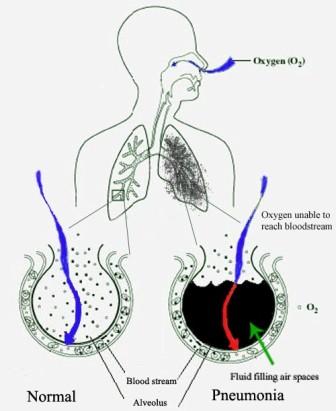Hospital-acquired pneumonia history and symptoms
|
Hospital-acquired pneumonia Microchapters |
|
Differentiating Hospital-Acquired Pneumonia from other Diseases |
|
Diagnosis |
|
Treatment |
|
Case Studies |
|
Hospital-acquired pneumonia history and symptoms On the Web |
|
American Roentgen Ray Society Images of Hospital-acquired pneumonia history and symptoms |
|
Hospital-acquired pneumonia history and symptoms in the news |
|
Directions to Hospitals Treating Hospital-acquired pneumonia |
|
Risk calculators and risk factors for Hospital-acquired pneumonia history and symptoms |
Editor(s)-in-Chief: C. Michael Gibson, M.S., M.D. ; Philip Marcus, M.D., M.P.H.
Overview

People with pneumonia often have a productive cough, fevershaking chills, shortness of breath, pleuritic chest pain, hemoptysis, headaches, sweaty, and clammy skin. Other possible symptoms are loss of appetite, fatigue, cyanosis, nausea, vomiting, mood swings, and joint pains or muscle aches. In elderly people manifestations of pneumonia may not be typical. They may develop a new or worsening confusion or may experience unsteadiness, leading to falls. Infants with pneumonia may have many of the symptoms above, but in many cases they are simply sleepy or have a decreased appetite. In VAP, often no history is available in patients with ventilator-associated pneumonia as they are often sedated and are rarely able to communicate.
History and Symptoms
Common Symptoms
- Dyspnea
- Productive cough (greenish or yellow sputum)
- Fever (high grade) with sweating, chills, and rigor
- Pleuritic chest pain
- Rapid, shallow breathing
Less Common Symptoms
Elderly
The manifestations of pneumonia, like those for many conditions, might not be typical in older people. They might instead experience:
- Delirium
- Hypothermia
- Falls
Infant
Atypical Pneumonia
Major Points and Recommendations for Diagnosis of Adults with Hospital-Acquired, Ventilator-Associated, and Healthcare-Associated Pneumonia [1]
All patients should have a comprehensive medical history obtained and undergo physical examination to define the severity of HAP, to exclude other potential sources of infection, and to reveal the presence of specific conditions that can influence the likely etiologic pathogens (Level II)
For Level of evidence and classes click here.
References
- ↑ "Guidelines for the management of adults with hospital-acquired, ventilator-associated, and healthcare-associated pneumonia". American Journal of Respiratory and Critical Care Medicine. 171 (4): 388–416. 2005. doi:10.1164/rccm.200405-644ST. PMID 15699079. Retrieved 2012-09-13. Unknown parameter
|month=ignored (help)